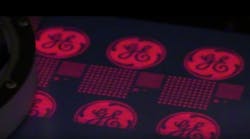Austriamicrosystems has announced the AS1123 16-channel LED driver for applications in large LED panels and video walls in indoor/outdoor applications. The company has also announced the AS1130 driver capable of powering 132 LEDs for small dot-matrix displays in applications such as mobile phones, toys, and other personal electronics. The AS364x series of drivers for LEDs used as a camera flash in mobile phones and dedicated digital cameras was also announced recently.
The AS1123 driver dedicates an output channel to each LED in large-scaled LED display applications. Users can cascade the drivers using a serial interface to support extremely large numbers of LEDs. Applications range from large high-definition video boards in locations such as stadiums to much simpler signs that scroll text messages.
austriamicrosystems says that the architecture driving a single LED with each output channel saves power relative to other schemes. The output voltage range can be set as low as the forward voltage of a single LED thereby eliminating wasted power that is dissipated as heat in other schemes.
"Large video walls such as those designed to the HDTV standard have an increased number of LEDs," said Rene Wutte, austriamicrosystems’ marketing manager for lighting. "Since a full HD display uses 6 million LEDs, it’s important that the LED driver is optimized for power since saving a few milliwatts per LED times 6 million yields power savings in kilowatts. This not only results in cost savings during operation of the LED display, but also allows green and eco-friendly design as every saved kWh saves more than half a kilogram of CO2, a key selling feature that’s becoming more and more important."
The driver features protection against over-temperature, open-LED, and shorted-LED conditions. The driver outputs actually sink drive currents as high as 40 mA. An external resistor sets the drive current level. The company says that current accuracy is +/- 3% between LED channels – including across multiple cascaded drivers.
Personal LED displays
While most people think about LEDs in portable applications as backlight drivers, the new AS1130 multiplexes 132 LEDs to create a dot-matrix display and designs that utilize RGB LEDs can support full color. The IC includes 36 memory frames to store animation patterns for the display.
The IC can be utilized in either battery- or line-powered applications. "It enables driving a large number of RGB LEDs from one IC for creative light designs while providing the highest efficiency available, an important feature for both battery-powered and AC-powered applications," said austriamicrosystems' Wutte. "The AS1130’s features simplify design and programming, optimize total cost, and allow developers to provide the lighting features required to stay ahead in this market."
The integrated multiplexing capability simplifies the system design in LED display products. A single device can replace eight 16-channel PWM LED drivers according to the company. The AS1130 requires only 5 mm2 of circuit board real estate.
Photo-flash applications
The new AS364x driver series, meanwhile, is targeted specifically at photo-flash applications with family members offering drive currents ranging from 320 mA to 2A. The family is intended to span applications ranging from entry-level cell phones to high-end digital still and video cameras.
The highest-power family member – the AS3648 – can drive 1A into each of two LEDs. The company said that such an implementation requires 22 mm2 of circuit board space and claims that's the smallest footprint of a photo-flash LED driver in the industry. The 320-mA AS3644 and 500-mA AS3642 occupy and even smaller footprint requiring 11 mm2.
The new family includes programmable flash timing and support for torch and autofocus modes, increasing the quality of photos that can be captured. "Taking high quality photos in low-light situations using the camera-flash is becoming more and more critical to consumers who now want the best quality pictures with their mobile device. The photo-flash used in most phones is migrating from a simple LED light to a high quality flash," said Oliver Weber, austriamicrosystems’ marketing manager for mobile lighting products. "We specified our new AS364x series of flash-drivers with the end-customer in mind, based on our extensive experience working with leading OEMs. This family supports the next generation of mobile products with enhanced features and improved picture quality."
The drivers operate from Li-Ion batteries with input voltage ranging from 2.7-4.4V. The input voltage range allows the flash to continue to operate as the battery charge erodes. A boost DC-DC converter with 4-MHz switching frequency drives the LEDs.







